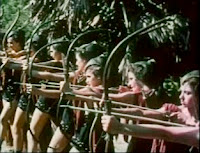6'1" Steve Reeves became Mr. Universe in 1950. He became interested in bodybuilding as a teenager and promoted natural bodybuilding throughout his life. He had a difficult time in Hollywood where most people appreciated him only for his body and not his acting ability. The film that made him truly famous was 1958's Hercules. Reeves would go on to star in the sequel the following year and then appeared as a slew of other muscled heroes in Italian epics through the late 1960s. He died of lymphoma in 2000 on the same day that Ridley Scott's Gladiator premiered.
Friday, April 29, 2011
Saturday, April 23, 2011
Hercules (1958)
When people think of sword and sandal films or of Hercules, the first thing that comes to mind is usually this 1958 classic. Directed by Pietro Francisci (who would go on to direct Hercules Unchained the following year) and starring Steeve Reeves as Hercules this film defines the genre.
The film's original title in Italian is Le fatiche di Ercole. When it was dubbed in English it received the simple title, Hercules. The film is wonderful mish-mash of various myths with the bulk of the story plot being drawn from Argonautica.
On the road to Iolcus, Hercules encounters King Pelias' daughter, Princess Iole (Sylvia Koscina). A romance begins to blossom and they travel on together. The Golden Fleece has been stolen and when Jason, the rightful king of Iolcus, arrives home King Pelias immediately sends him off on a quest to retrieve the Fleece in Colchis.
Pelias has been informed by a seer (Lydia Alfonsi) that Jason will challenge his claim to the throne--rightly so, for Pelias has killed his brother, Jason's father.
Hercules sets sail with Jason and many other Heroes, including a young Ulysses who becomes something of a protege for Hercules, aboard the Argo.
The Argonauts survive a storm at sea and land on the lush island of the Amazons. Here, Jason falls in love with the Amazon queen, Antea (Gianna Maria Canale). The Amazons are, of course, not what they seem. They plot the destruction of the heroes. Hercules alone has not fallen into the thrall of the Amazons and he manages to convince Jason to leave. The Argo sails off in the night.
When the Argo arrives at Colchis, Jason must battle a massive dragon to retrieve the Fleece. He does so successfully and the Argonauts return to Iolcus. Shocked that the heroes have returned successfully, Pelias (Ivo Garrani) denies Jason's claim to the throne and a battle between the heroes and the king's forces begins.
In the most famous scene from the film, Hercules stops Pelias' cavalry by toppling a palace on them. The chains were apparently made of wood and painted to appear metal. When Steve Reeves tried to swing them somewhat gently so as not to hurt the other actors, the director is supposed to have said "They don't get hurt, they don't get paid!"
Finally, Jason takes his place as rightful king of Iolcus and Hercules and Iole set sail for further adventures.
This film begins the trend of creating composite myths--drawing from many sources to create a new story. Purists may balk at this practice but we wouldn't have the sword and sandal genre without it!
Hercules is now in the public domain so there are many countless DVD versions available. The only ones I have seen are the dubbed English version. You can view the entire film Online at the Internet Archive.
Thursday, April 21, 2011
Statue from Troy
Abacus Props and Costumes is sadly going out of business. They have a warehouse full of pieces, mostly from Warner Bros. productions. Luckily for me, I was able to pick up this small statue from Troy for a great price!
The statue seems to be made of molded plaster and is painted gold. It's about a foot tall and quite heavy.
Several statues like these can be seen in the Trojan temple of Apollo in the film. They appear on a series of shelves inside the archways and also on the temple altar.
The statue seems to be made of molded plaster and is painted gold. It's about a foot tall and quite heavy.
Several statues like these can be seen in the Trojan temple of Apollo in the film. They appear on a series of shelves inside the archways and also on the temple altar.


























